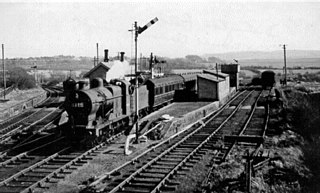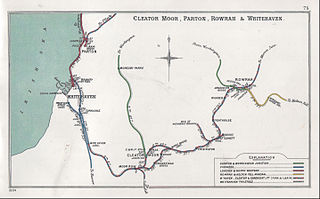
RNAD Broughton Moor is a decommissioned Royal Naval Armaments Depot located between Great Broughton and Broughton Moor in the County of Cumbria, England.

RNAD Broughton Moor is a decommissioned Royal Naval Armaments Depot located between Great Broughton and Broughton Moor in the County of Cumbria, England.

The depot was opened in 1939 on the site of Buckhill Colliery (opened 1873, closed 1932; the colliery's spoil heap remains a prominent feature of the site to this day). In 1944 the site was expanded from 800 to 1050 acres. [1]
The depot continued to be used by the Ministry of Defence until 1963, at which point it was leased to the Federal Republic of Germany. From 1977 it was used by the United States Navy for storage of armaments for its North Atlantic Squadron (the weapons were flown out of the site by helicopters shuttling back and forth over a number of days to a USN Cargo Ship lying offshore and away from the town's harbour of Workington); and from 1981 Broughton Moor was formally adopted as a NATO storage site. [1]
The site was decommissioned at the end of the Cold War, finally closing on 31 December 1992. [1]
The site had a 2 ft 6 in (762 mm) narrow gauge railway. Locomotives from this railway are preserved on the Almond Valley and Whipsnade railways. In 1970 the locomotives in use at Broughton Moor consisted of: [2]
The site was connected to the main line via a 5 miles (8.0 km) branch line to Siddick Junction, north of Workington railway station and utilised a headshunt at Northside to change direction northbound on to the Cumbrian Coast Line. [3] The branch closed on 4 June 1992, being the last part of the Cleator and Workington Junction Railway in operation.
The railway equipment at RNAD Broughton Moor was sold by tender in April and July 1992 and consisted of approximately 3 miles of standard gauge track and 25 miles of narrow gauge (2 ft 6in) track. The sale also included 4 standard gauge locomotives built by Ruston & Hornsby and Hunslet, 27 narrow gauge locomotives by the same builders and 127 wagons, including 6 box vans, 4 brake vans (2 x 4tons & 2 x 6 tons) and 99 flat wagons. [4]
An explosion occurred at RNAD Broughton Moor on 18 January 1944 which resulted in the death of 11 people and left 70 people injured. The coroners hearing was reported in the Cumberland Evening Star in February 1944. The explosion appears to have occurred in one of the traverse laboratories, photos showing the aftermath include a 2 ft 6 in (762 mm) gauge box van No. 267.[ citation needed ]
The large majority of the buildings and bunkers remain along with underground storage and an extensive network of storage sheds and other military buildings. Ownership of the site was transferred from the Ministry of Defence to Allerdale Borough Council in 2008 who have yet to decide what to do with the site. The site was purchased by the Borough Council for £1. In October 2008 Cumbria County Council called for interest in the redevelopment of the site rebranded as Derwent Forest. As yet there has been little interest due to the huge cost involved with cleaning up the site. There are unexploded ordnance and large amounts of asbestos as well as unmarked mine shafts when it was a colliery prior to World War II. Furthermore, having previously ruled out allowing the site to be used for coal mining, Allerdale council later agreed to allow mining by any prospective future owners as a way to raise funding for any potential tourism development. [5]
It was announced on 13 January 2011 that the two shortlisted developers for the site would not mine the site, allaying fears about the environmental impact of the development of the site. A decision is due by the end of February 2011. [6]
On 31 August 2018 the Derwent Forest Development Consortium and utropia revealed a masterplan to develop the site including 1200-2000 houses, a hotel, lodges, and other facilities. [7] Work was due to begin in 2020.Planning permission for building houses on the site was rejected by the local council in 2022.

The Tanfield Railway is a 4 ft 8+1⁄2 instandard gauge heritage railway in Gateshead and County Durham, England. Running on part of a former horse-drawn colliery wooden waggonway, later rope & horse, lastly rope & loco railway. It operates preserved industrial steam locomotives. The railway operates a passenger service every Sunday, plus other days, as well as occasional demonstration coal, goods and mixed trains. The line runs 3 miles (4.8 km) between a southern terminus at East Tanfield, Durham, to a northern terminus at Sunniside, Gateshead. Another station, Andrews House, is situated near the Marley Hill engine shed. A halt also serves the historic site of the Causey Arch. The railway claims it is "the world's oldest railway" because it runs on a section dating from 1725, other parts being in use since 1621.

The Lincolnshire Wolds Railway (LWR) is a heritage railway based at Ludborough station, near Louth, Lincolnshire, England and the only standard gauge steam railway in Lincolnshire open to the public. The line is part of the original Great Northern Railway (GNR), a rail system that opened in 1848 and once linked Grimsby, Louth and East Lincolnshire with London. In early 2002, 2009 and 2013 the Lincolnshire Wolds Railway received a top national award from the Heritage Railway Association for its heritage railway efforts.

The Northamptonshire Ironstone Railway Trust operates a 1+1⁄2-mile (2.4 km) long heritage railway line at Hunsbury Hill, south-west of Northampton. The line is mainly dedicated to freight working, featuring many sharp curves and steep gradients which were typical of the industrial railway, but rides are available in a variety of vehicles including a converted brake van.

The Scottish Industrial Railway Centre is an industrial heritage museum operated by the Ayrshire Railway Preservation Group. The centre owns a number of standard gauge steam locomotives and diesel locomotives as well as some narrow gauge items and an extensive collection of photographs.

Hudswell, Clarke and Company Limited was an engineering and locomotive building company in Jack Lane, Hunslet, Leeds, West Yorkshire, England.

Broughton Moor is a village and civil parish in Cumbria, England. It is situated on an extensive moor about 2 miles (3.2 km) north of Broughton, 5 miles (8.0 km) north west of Cockermouth, 2.5 miles (4.0 km) south of Maryport and 4.5 miles (7.2 km) north of Workington.

Camerton railway station was situated next to the River Derwent on the Cockermouth and Workington Railway. It served the village of Camerton, Cumberland, England.

Southall Railway Centre is a non-publicised railway heritage centre at Southall in west London, near Southall railway station and the Grand Union Canal. Formerly of the Great Western Railway the site is now run partly by Locomotive Services and West Coast Railways, both of whom lease the site from Network Rail. The location is not open to the public.

Workington Central railway station was opened by the Cleator and Workington Junction Railway (C&WJR) in 1879 to serve the town of Workington in Cumberland, England. It was situated almost half a mile nearer the town centre than its rival Workington station.

Camerton is a small village and civil parish in Cumbria, historically part of Cumberland, near the Lake District National Park in England. According to older maps, it was originally called "Camberton".

Great Broughton railway station briefly served the village of Great Broughton, near Cockermouth in Cumberland, England.

Seaton railway station served the village of Seaton, near Workington in Cumberland, England.

RNAD Trecwn is a decommissioned Royal Navy Armaments Depot, south of Fishguard in the village of Trecwn, Pembrokeshire, West Wales.
Moresby Junction Halt railway station was opened by the Cleator and Workington Junction Railway (C&WJR) in 1910. Very few people lived near the halt, which served nearby Walkmill Colliery and coke ovens in Cumbria, England.
Keekle Colliers' Platform railway station was opened by the Cleator and Workington Junction Railway (C&WJR) in July 1910, closed the following January, reopened in June 1913 then closed for good on 1 October 1923. The halt was provided to enable residents of the isolated Keekle Terrace, less than 100 yds from the track, to get to and from work at the equally isolated Walkmill Colliery and coke ovens in Cumbria, England. The Platform is not shown by Jowett.

Distington railway station was opened jointly by the Cleator and Workington Junction Railway (C&WJR) and the LNWR and Furness Joint Railway on 1 October 1879. It was situated on the northern edge of the village of Distington, Cumbria, England, where the C&WJR's north–south main line crossed the Joint Line's east–west Gilgarran Branch.

Linefoot railway station, sometimes referred to as Linefoot Junction and sometimes as Linefoot Goods, briefly served the scattered community around the crossroads at Linefoot, near Cockermouth in Cumberland, England.

Camerton Colliery Halt railway station was an unadvertised halt for workers at one or both of the collieries at Camerton, near Cockermouth in Cumberland, England.

Buckhill Colliery Halt railway station was an unadvertised halt for workers at Buckhill Colliery north east of Camerton, near Cockermouth in Cumberland, England.

Oatlands railway station served the village of Pica and Oatlands Colliery in the former English county of Cumberland, now part of Cumbria.
{{cite web}}: CS1 maint: unfit URL (link)